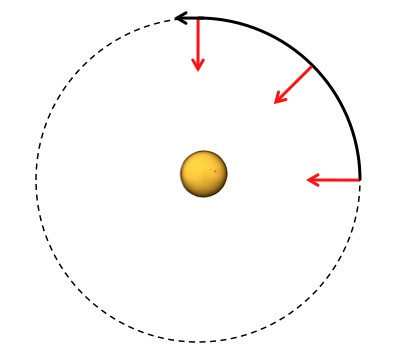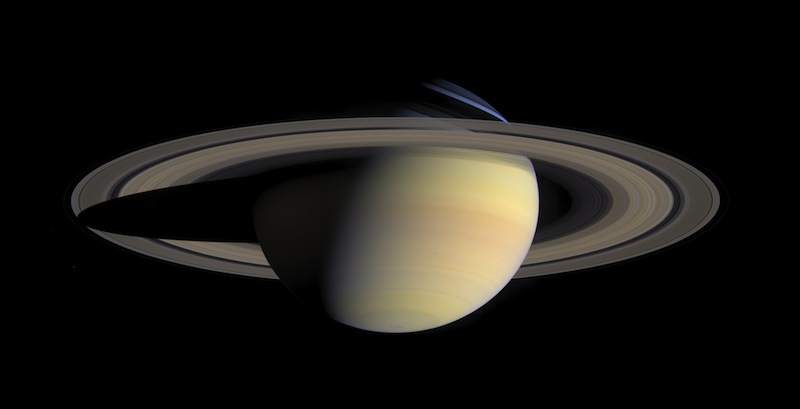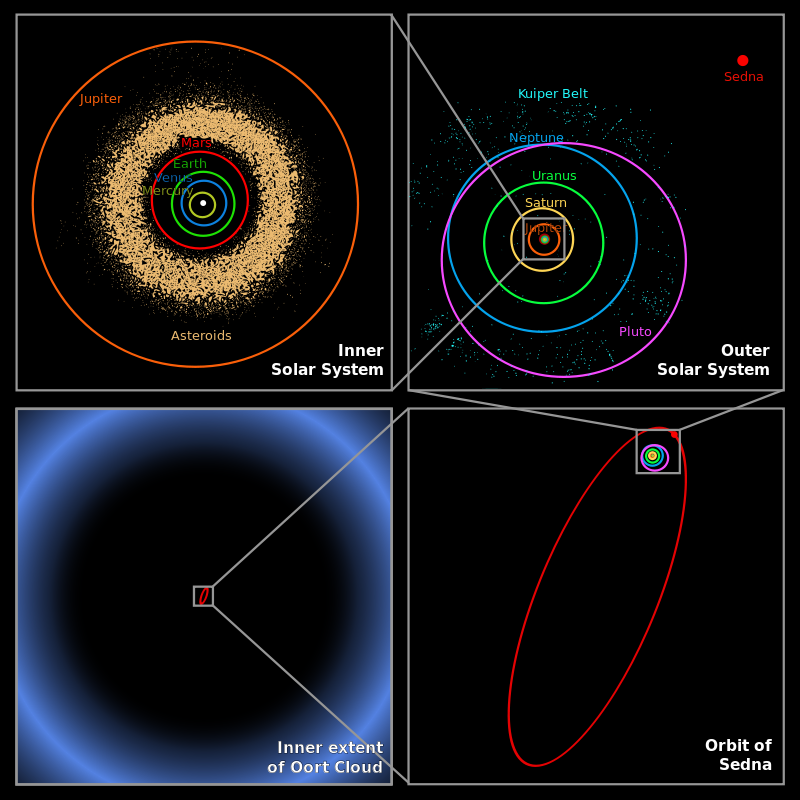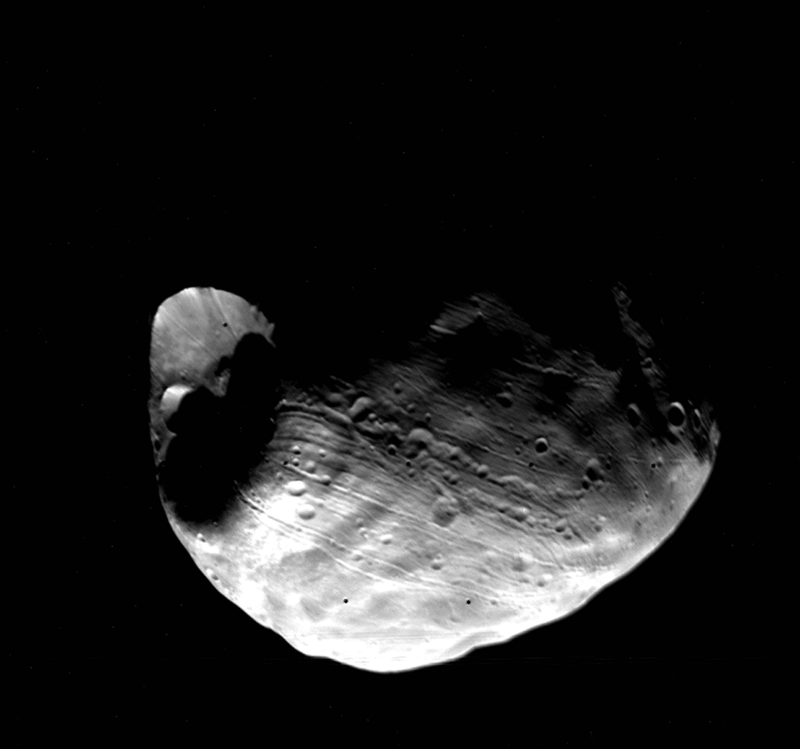Physicist: Newton’s laws of motion say:
Where MP and AP are the mass and acceleration of a planet, MS is the mass of the Sun, R is the distance between them, and G is a universal constant. What this rather bold statement says is “if you exist near the Sun, then you are accelerating toward it”. Each of the planets, moons, grains of dust, etc. all say the same thing (“Hey! Accelerate toward me!”), it’s just that with 99.86% of the mass in the solar system, the Sun says it loudest.
A force, like gravity, accelerates the object it acts on. So to understand what a force does it’s important to understand acceleration. Velocity describes how fast your position is changing, while acceleration describes how fast your velocity is changing.
“Velocity” is different from “speed” because velocity is a description of how fast you’re going and in which direction; “10 mph north” is a velocity, while “10 mph” is a speed. So you can have an acceleration that changes your velocity by changing your speed and/or by changing your direction.
Imagine you’re in a car (your velocity points forward):
If you accelerate forward, you speed up.
If you accelerate backward, you slow down (“decelerate”).
If you accelerate to the right or left, you turn in that direction but maintain the same speed.
Notice that when you talk about acceleration this way, suddenly the push you feel into your seat when you step on the gas is the same as the push you feel into your seat belt when you brake is the same as the centrifugal force pushing you to the left when you turn right.

A planet orbiting the Sun is always accelerating toward it. But rather than changing the planet’s speed, the acceleration changes the planet’s direction.
With planets the same rules apply. A planet moving around the Sun in a circular orbit always has the Sun about 90° to the side of the direction they’re moving. This means that the planet is always turning, but always moving at about the same speed. The planets are moving so fast that by the time they’ve turned a little, they’ve moved far enough that the Sun is in a new position, still 90° to the side.
So that’s how a planet can accelerate toward the Sun forever without getting any closer. The sideways motion of planets is due to the fact that if a planet were not moving sideways, it would find itself in the Sun in short order. In fact, the Sun is nothing more than a massive collection of all the matter from the formation of the solar system that wasn’t moving sideways fast enough (which is nearly all of it).
Why things end up in circular orbits is a more subtle question. The quickest explanation is that things in not-circular orbits run into trouble until either their orbit is sufficiently round or they’re destroyed. It’s not that circular orbits are somehow better, it’s just that other orbits carry more risk of serious impacts or gravitational interactions (e.g., with Jupiter) that may lead to short, unfortunate orbits.
Assuming that an orbit is stable, then it will be an ellipse (there’s a post here on exactly why, but it’s a whole thing.). A circle is the simplest kind of ellipse, but ellipses can be extremely stretched out. For example, comets have very elliptical orbits (like Sedna in the picture below). In these orbits the comet is mostly moving toward and away from the Sun, so for them the Sun’s pull mostly changes their speed and changes their direction less.
There’s nothing special about the orbits the planets are in. The eight (or nine or more) planets we have in the solar system aren’t the only planets that formed, they’re the only planets left. When things are in highly elliptical orbits they tend to “drive all over the road” and smack into things. When things smack into each other one of a few things happen; generally they break or they don’t. When we look at our planetary neighbors we see craters indicating impacts right up to the limit of what that planet or moon could handle without shattering. Presumably there should be impacts bigger than a planet can stand, but (not surprisingly) those impacts don’t leave craters for us to find.
So objects with extremely elliptical orbits are more likely to get blown up. But even when two objects hit each other and merge, the resulting trajectory is an average of both objects’ original trajectories, and that tends to be more circular. This is a part of accretion, and Saturn’s rings provide a beautiful example of the nearly perfect circular orbits that result from it.

The grains of dust in orbit around Saturn bump into each other and slowly average out until their orbits are almost perfectly circular (which means they bump into each other far less often).
Given a tremendous amount of time, a big blob of material in space tends to condense into a ball (with most of the matter) and a thin disk of left over material traveling in circular orbits around it.









Brilliant and stunningly simple answer. Very useful! I will be ‘lifting’ portions of this in future discussions.
Winning sentence:
In fact, the Sun is nothing more than a massive collection of all the matter from the formation of the solar system that wasn’t moving sideways fast enough (which is nearly all of it).
Based on that, shouldn’t you weigh more when you’re on the side facing the sun as you’re closer and weigh less when you’re on the night side 7500 miles further away. I suppose if the moon was overhead you’d weigh even less as its upward pull of gravity would also negate your weight at night.
@George Clark III
The difference in gravity from the Sun between the day and night sides of the Earth is very small, but it is responsible for the “solar tide” which is a lot like the regular tide (lunar tide), just weaker.
By the way, it would certainly once be interesting to tackle a bit the conspiracy theory about the Moon…some argue it might have been “engineered” since when hit with TNT, it “rang” like a bell, letting to suspect it might be hollow under the surface…so artificial or not, the Moon would be a hot topic. Thanks!
I still don’t get it. If I shoot a rocket toward the sun, will the suns gravity move it into orbit or will it fall into the sun?
@Tim – If you are a good shot, your rocket will fall into the sun. If you miss and it is moving at the right speed, it wall fall towards the sun but just keep missing forever ( in orbit).
SIMPLY THE BEST ANSWER……..
Sun is a moving body. How is it physically possible for another free body to orbit around sun in any type of geometrically closed path?
@Nainan K. Varghese
The closed path is relative to the Sun. If we think of the Sun as moving, then clearly everything that orbits around it moves in more of a “corkscrew”.
Why can’t planets orbit the sun sideways?
Also, why do so many planets orbit counter-clockwise?
Thanks.
I think it will be more correct if the statement “The closed path is relative to the Sun. If we think of the Sun as moving, then clearly everything that orbits around it moves in more of a “corkscrew” ” is presented as “The closed path is relative to assumed static state of sun. As the sun is a moving body, every body orbiting about it clearly move in wavy path about sun’s path.”
As sun’s path is circular around static galactic centre, all macro bodies in solar system has to move in the same angular direction and in the plane of sun’s circular path.
how does the recent revelation that the galaxy is 50-60% heavier than previously thought (if we can assume that is a constant throughout the universe)…how does that change the amount of dark matter needed to keep our galaxy from flying apart and in turn how much of the believed dark matter in the universe actually exists?
also.. supermassive black holes merge… the presence of a supermassive black hole can warp and twist spacetime through its rotating at close to the speed of light.. if one SMBH can warp spacetime… can several merged supermassive black holes ever grow large enough to actually begin to wrap spacetime itself up? and could that be what the great attractor is…
so if the earth travels around the sun, it would need a inicial velocity, correct? other wise it would be pulled straight into the sun, right? where did that inicial velocity come from and what were the chances that we ended up with a very circular orbit and not one like pluto’s? it seems very unlikely that this circumstance would occur. what were the chances that we ended up at a perfect distance from the sun to have an abundance of life? and what are the chances that all these circumstances happened to the same planet?
what law says planets do not move in a circle
The orbits around a star are not circular ! The orbits are elliptical ! Therefore, during one leg of the orbit an object will accelerate due to a stars gravitational pull. During another leg of that same orbit, an object will slow. This is all due to elliptical orbits & centrifugal force !
Lol, gravity is a push, not a pull, that is a fantasy! If mass actually pulled things together, Jupiter could have no rings, etc – everything would be stuck together! Gravity is a push from all around, a planet is like a submarine – pressure all around. What kind of physicist is this guy that has formulas and no observations??
A couple hints for the confused.
Yes, orbits are elliptical but with very little eccentricity hence they differ from circles by very little & circles are really just rounder ellipses.
—
Planets and sun are where they are because that’s where they ended up after sweeping up much of the debris that was the original local dust cloud. It was collisions between particles within the dust cloud that provided the energy for the planets initial velocities. Stuff that had the velocities to remain in orbits did. Anything with the wrong velocity went somewhere else. All of this took a very long time.
—
I suspect that most planets orbit in the same direction because that is the rotational direction that resulted from the early collisions within the dust cloud. It’s either that or the right hand rule. Of perhaps a bit of both.
—
If you shoot a rocket into the sun it will likely do so. If you shoot a rocket near the sun with enough just the right velocity then it might enter an orbit about the sun.
—
You are in fact lighter at noon than at midnight. Gravitational attraction varies by the square of the distance between the affected bodies. Earth’s average orbital radius is about 93 million miles. Earth’s diameter is about 4 thousand miles. Whipping out a napkin… At noon the sun is pulling you away from the center of the earth from a radius of 92,996,00 miles; while at midnight it is pulling you toward the center of the earth from a radius 93,004,000 miles. Square those two values & compare them; you get a relative difference of about 0.00017%. Give or take a guesstimate or two. All values are gross approximations.
—
As for gravity. It is the measurable tendency of two or more objects to occupy the same space at the same time.
—
As always, YMMV.
its because of the centripetal force and gravitational pull……centripetal force’s speed and gravitational force’s speed is equal……as the centripetal force helps it to revolve …eart is attracted by the sun ….as the speed is equal….it keeps the balance and revolve around the sun and do not move away from the sun
Since the sun is ultimately growing, will its gravitational pull increase with the increase of surface area? I.e. Will the growing sun eventually start pulling in planets that are closer to it as it grows? Thanks!
Starting from the formation of Solar system, Sun has accumulated upto 99.86% of Mass becuase all these dust clouds initial velocity were not right angle to Sun’s mass.. Only 0.14% particles velocity happened to be 90 and so they are now going round in an orbit..
These was proved experimentally by launching setellites at right angle to the Earth with intial orbital velocity.. found that satellites starts orbiting Earth…
planets move in elliptical path or round ? if its elliptical the gravity and centripital force co relate on a planet at the extreme side of the orbit
Everything in the universe moves elliptically. From atoms to galaxies to hurricanes to your toilet. There are 4 forces in the universe: strong; weak; gravity; and electromagnetism. These forces cannot be divorced from one another. They are required by physics to work in unison. These rules demand that everything be as circular as possible. Elliptical orbits are the result of multiple forces acting upon a body in motion. When the Earth soon comes closer to Mars than in 60K years they will interact and the result will be measureable. , though we will feel nothing.
Telescopes show that all galaxies have strong elliptical patterns. There are no exceptions.
The push on planets comes from another dimension, outside time and space. Trying to find the answers here is not accurate. How do I know? I am from that dimension.